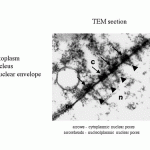Quick look:The nuclear envelope of a cell is a barrier layer that envelopes the contents of the nucleoplasm in the cells of eucaryotes. Recent research has indicated that the nuclear envelope is not roughly spherical, as often depicted, but has clefts that dive into the rounded structure to form valley-like channels and tubules.
Nuclear envelope – what it might be like without it?
Imagine what it would be like if into a washing-up bowl you poured a little of each of all your household chemicals and medicines. Your washing up liquid, your aspirin tablets, laundry detergents, cough linctus and pastilles etc. and then added a hank of loose string. It would be chaotic, a right tangle! That is what it would be like inside a cell where it not for the organelles and vesicles keeping chemicals and reactions separate from one another.
Nuclear envelope – how it helps.
The nuclear envelope keeps the contents of the nucleus, called the nucleoplasm, separate from the cytoplasm of the cell.
The all-important genetic material, mainly the DNA is kept separate and relatively safe from the chemical reactions taking place in the cytoplasm. The separation also makes it possible for chemicals in the nucleus to (1) prepare for and take part in the replication of genetic material prior to nuclear division and, (2) manufacture different types of RNA for export to the cytoplasm.
Nuclear Envelope – now you see it, now you don’t.
The postman delivers an envelope. Just before you want to look at the contents the envelope unwraps itself and shreds and shrinks into little pieces leaving the contents exposed. When you have read the letter the shredded bits reform as an envelope around the contents and seals itself up. If this were a movie you would call this trick photography or science fiction. In the language of the cell it is science fact. Every time a cell divides this is just what happens to the nuclear envelope. During early mitosis (prophase) the nuclear envelope breaks up or disassembles. During telophase in late mitosis the nuclear envelope is re-assembled by the joining together of the tight fitting envelopes that have formed around the chromosomes. By doing this the resulting nuclear envelope is ‘sealed up’. Truly wondrous.
The breaking up or disassembly of the nuclear envelope is thought to be brought about by depolymerization and that ubiquitous of cell reactions, phosphorylation.
Re-assembly of the nuclear envelope is brought about by dephosphorylation and repolymerization.
Nuclear Envelope: the structure of the ultimate self-assembly kit
The nuclear envelope is composed of two concentric lipid bilayer membranes separated by an intermembrane space of about 20-40 nm.
The outer membrane is continuous in many places with the rough endoplasmic reticulum. Like the rough ER the outer membrane of the nuclear envelope is dotted with ribosomes.
Attached to the nucleoplasm side of the inner membrane is a sheet-like structure of protein filaments called the nuclear lamina. This lamina looks like loosely woven hessian and is thought to help give strength and support to the nuclear envelope and possibly provide an anchor point for chromatin fibres.
Recent work suggests that the nuclear envelope is not a spherical coat as portrayed in many textbook diagrams.
New imaging techniques using special dyes, lasers and confocal microscopy indicates that the nuclear envelope surface cleaves or invaginates to produce channels that can be so deep that they form tubules in the nucleoplasm. Some of these channels are deep while others are shallow. Tests have revealed that both the membranes of the nuclear envelope enter the cleavage and that the channels are long-term structures. It is possible that the channels bring more nuclear pores into contact with those parts of the nucleoplasm that would otherwise be well away from the surface and therefore the cytoplasm.
In mammals the nuclear envelope is perforated by about 3000-4000 nuclear pores. These pores permit chemical traffic to move through the barrier to and from the nucleus.
If you are questioning whether there is any point in having a barrier between the nucleoplasm and cytoplasm with 3000-4000 holes in it, you are beginning to question the nature of the holes. They are certainly worth looking into. You will be amazed at what you see.
Take a look at the item on the nuclear pore and be amazed!
Summary
- In the nuclear envelope we have an example of a robust biological barrier formed from two concentric membranes with a minute gap between them.
- Passage through the barrier is strictly controlled in both directions for all chemical traffic except small molecules.
- The entry and exit of all chemical traffic can only be made at specific points called nuclear pores
- The robust nuclear envelope protects the material in the ‘Head Office’ of the cell from unwanted attack and interference.
- The nuclear envelope ensures that the genetic material is kept for future replication of the cell and for issuing uncorrupted instructions to the cytoplasm (but some viruses have managed to hack the entry code!).
- When cell division takes place the envelope is disassembled into fragments and then reassembled as two new envelopes.
